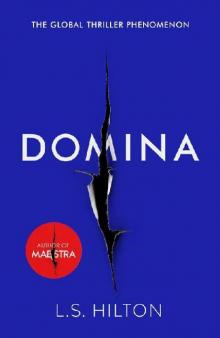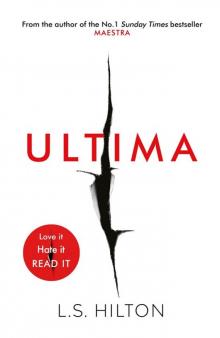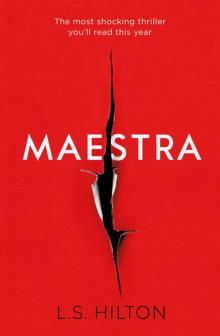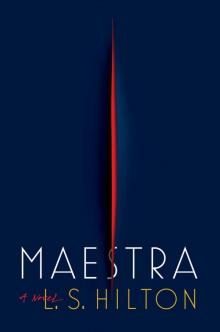- Home
- L. S. Hilton
Domina Page 2
Domina Read online
Page 2
2
‘Miss Teerlinc? Elisabeth Teerlinc?’
‘That’s me.’
‘I’m Tage Stahl. I hope you don’t mind me gate-crashing, but I couldn’t help being fascinated by the pieces.’
‘I’m delighted.’
‘Have you had the gallery long?’
‘Not really – just since the spring.’
‘Well, it’s a wonderful space.’
‘Thank you. Please enjoy the show.’
The client drifted off into what felt like a crowd, though Gentileschi only held about thirty people. My space may only have been fifteen paces long, but every stride I took across it belonged to me. The gallery was on the ground floor of the disused naval buildings at the very bottom of the island, near the San Basilio vaporetto stop: plain nineteenth-century functional architecture, which contrasted with the glorious view to the east of Giudecca. The beauty of Venice is a bore’s topic – one can say nothing that hasn’t been said better already – but I liked my gallery better for that, its gesture towards the origins of this city whose enchantments were built on ships and sweat and spices.
My first Italian presentation was a group show of Serbian artists, the Xaoc Collective, who worked out of a squat in Belgrade. The pieces – embroidered collages and canvases set with whimsical found objects – were folksy and deliberately apolitical, undemanding and easy on the eye, as were the prices. And they were selling. They were actually selling. I’d decided to start with a modest August opening. Elisabeth Teerlinc had managed to meet many of the people she needed to know as the Biennale caravan passed through Venice in the spring, but she was a long way off being established. The relatively quiet months around the film festival, when the city belongs mostly to tourists and the dwindling number of Venetians who serve them, had been a perfect time to cultivate my contacts and new identity in prepar-ation for its next arrival.
I’d spent weeks writing the invitations for the viewing, assembling a short press release, choosing the exact grey linen papers for the catalogue and negotiating with a painting firm to re-whitewash the gallery’s walls. (Buyers of contemporary art expect white walls the same way they expect works to be confrontational, ambiguous or subversive.) Not much different to the busywork I had done back at my day job at the House in London, but the difference was everything. For a start I had a proper desk, a Poltrona T13, based on the 1953 Albini model, which impressed Italian visitors if no one else, and I could actually sit at it without being harangued for idleness. I didn’t have an assistant yet – I’d rounded up a few students from the university to hand round prosecco and take jackets – but they referred to me as ‘Signora Teerlinc’, rather than ‘Er’.
Just for a moment I wished that I could reach back, pull apart the web of all that had happened and show my younger self my future. These guests and these glasses were real, as were the handwritten labels which the students were fixing one after another next to the pieces to show that they were taken. Standing there, poised, polished, confident, even I felt real. My success might have been relatively modest, but it didn’t make me feel humbled. It made me feel delighted.
Across the room the Scandi-looking guy, Stahl, was flipping idly through my carefully written catalogue. I watched him signal to one of the students and reach for his wallet. He was buying. I made to walk over, but someone laid a hand on my arm and I turned back. An older man, serious in a proper tweed jacket despite the heat. I assumed he must be a lost tourist, or maybe a professor from the Ca’ Foscari university nearby, but the accent of his first careful words of English said Russian, so I nervously tried ‘good evening’.
‘You speak Russian?’
‘Not much, unfortunately.’ I switched to English. ‘Can I help you?’
‘You are Elisabeth Teerlinc?’
‘Indeed.’
He offered me a business card, formally, with a little bow. It gave his name, Dr Ivan Kazbich, and the address of a gallery in Belgrade, Serbia. He must have heard of Xaoc then.
‘Good. I have come to speak with you on behalf of my employer. Do you have a few moments, please?’
‘Oh. Well, certainly,’ I answered, intrigued.
‘I should prefer to speak with you alone.’
I glanced at my watch. Seven twenty-five. ‘Of course – if perhaps you wouldn’t mind waiting a little. The show’s just about to end.’
He glanced around the walls. Stahl had obviously bought the last three pieces, as every one now showed a ‘sold’ label in deep crimson ink.
‘You must be very pleased.’
‘Thank you. If you’ll excuse me a moment.’
I went to speak to Stahl, who was lingering as the last of the guests congregated at the door, exchanging goodbyes and plans for dinner. He asked if I would care to join him at Harry’s Bar, which ought to have told me everything I needed to know about him right then. If Venice is the greatest masterpiece our species has ever produced, why would one wish to dine in the only place without a view, where the only thing to look at is the joyless grotesques of the clientele? I bit my tongue, explained that I had an appointment and guided him politely but firmly out onto the quay, where the sky was just beginning to mist from sapphire to honeydew. I thanked the helpers, who had stacked the catalogues and tidied away the bottles and glasses, paid them in cash and closed the door behind them before joining Dr Kazbich.
‘Forgive me for keeping you waiting.’
‘Not at all.’
Kazbich explained that he worked for a collector who was interested in a valuation of his works, which were housed in France. Did I do such work? I hadn’t, for a while, but I had valued pieces back at the House, some with surprising results. It was a . . . significant collection, he continued. I knew what that meant. I asked if his client had considered using one of the experts at the IFAR, the International Foundation for Art Research. There was no question of provenance involved, he batted back, with a twitch of a smile that indicated we each knew the other knew what they were talking about. It was merely a private valuation. Dodgy then, but we both knew that too. The kind of offer no respectable girl should take, at least not until she knows how much it’s worth. On cue, the mystery employer was offering expenses, naturally, and a 20,000 euro consultation fee, with a further 100,000 on submission of the report. I would make an initial visit to assess the works and would then have two weeks to complete the valuation.
‘I could be very interested,’ I answered immediately.
I didn’t think someone who offered that kind of money would be impressed by time-wasting hesitations. Whatever the client wanted to do with the valuation was very much not my business. Dr Kazbich handed me a thick envelope, the colour of new butter, and waited expectantly while I opened it. Inside was a draft made out to Elisabeth Teerlinc, drawn on a bank in Cyprus, for the first sum, and another slip of paper with just a name. Pavel Yermolov.
For a moment, I stared dully at the name. Overwhelmed doesn’t happen to me very often. But Pavel Yermolov. I could see Pavel Yermolov’s pictures. Or rather, Pavel Yermolov thought I was good enough to see his pictures. I think Kazbich knew that I would happily have handed him back the money draft with the names reversed for the chance he was giving me.
Yermolov’s collection was a mystery, a matter both of legend and greedy rumour. A second-generation oligarch, he was reputed to be a very serious buyer, but he didn’t appear in the showrooms himself, preferring to acquire through a series of interchangeable and anonymous intermediaries. He had been connected with successful bids for a Matisse, a Picasso and, less predictably, a Jacopo Pontormo in the past five years, whilst a Pollock had definitely been bought in the name of one of his company trusts. And then there were the Jameson Botticellis.
Named for the American robber baron who had taken them dubiously out of Italy in the nineteenth century, the whereabouts of the Botticellis spun swiftly from rumour into conspiracy. Twinned medallion settings of an Annunciation and a Madonna and Child, the pictures had not been
seen by the public for a hundred and fifty years. Some websperts doubted their existence, claiming that they had been destroyed in a fire at the Jameson property in upstate New York and fraudulently reinsured to augment the family’s dwindling assets, others reported sightings in Qatar or Korea. Yermolov’s name had been associated with them in a murky sale a decade ago out of Zurich, but no one knew for certain if he owned them.
‘The answer is yes. Please tell Mr –’
He cut me off with a theatrical finger to his lips. ‘My employer expects total discretion.’
‘Of course, forgive me.’
‘Not at all, Miss Teerlinc. You have my card. When you are ready to travel, please contact me and I shall make the appropriate arrangements.’
He wasn’t wearing a hat, but as the gallery door closed behind him I was sure he had tipped it.
*
A short while later, in my flat on the Campo Santa Margherita, luxuriating in the bathtub with a glass of Soave, I was clutching the card like a talisman. I loved lying there in the early evenings, listening to the children playing in the square below, the girls swinging a washing-line skipping rope, the boys with their footballs and skateboards, as the market vendors packed up their boxes of squid and moleche and the cafés filled with tourists and students. It felt . . . neighbourly.
I was trying to visualise the pieces in Yermolov’s collection. The only thing I missed about my job at the House was the pictures themselves. So far, I had managed to avoid handling anything for which I felt actual contempt, but I couldn’t pretend to myself that the works Gentileschi had just sold were very much more than specious pieces of crap. I missed not only that initial sucker punch of beauty, but the privilege of spending time with paintings, the almost erotic anticipation provoked by their slow revelations, the way one could swoon into a picture, look and look again and still be moved, or disturbed, or astonished. My first visit to the National Gallery as a schoolgirl had changed my life, and ever since, paintings had been the only things that had never let me down. And fags, I suppose.
Thinking over my plans for the autumn, I realised Yermolov’s offer was not just extraordinarily flattering, but perfectly timed. The profits from the Balkan show would cover the gallery’s expenses for a while, but my flat and the work on it had eaten just over half of my available funds. Being rich is so expensive. I could have rented something when I arrived in Venice nine months ago, but the hunger for a place – a home, even – that was at last unassailably mine had been too powerful for prudence. The flat was owned by Gentileschi, paid for in cash through the gallery’s bank in Panama. I hoped to move eventually into the secondary market, selling good pre-owned pictures, but for the present I lacked the cash flow to deal anything other than ‘young artists’, under the 100K mark. Still, new work, which had no value beyond its status as currency, could be extremely lucrative if fashion was on its side. So I needed something splashy for the new season, a discovery that I could buy cheap and sell high next spring. There was a Danish girl who interested me; I’d seen her graduate show at St Martin’s in London online, and there was a series of simple graphic canvases, strangely compelling gold-ish orbs on sombre backgrounds that I thought would show very well against the syrupy light of the lagoon. Maybe a private view at dusk, if I could get them . . . Then there was my Russian to plod on with; it had seemed a practical language to have in my trade, now that so many Russians were buying art in the West, but it now looked as if I would need it sooner than I’d thought. I didn’t delude myself that Yermolov and I would be conversing in fluent Russian (if he even deigned to be present), but the sounds of the language were beginning to gel, and I thought I should make the effort to manage the basic courtesies.
I’d found a retired opera singer, Masha, who lived in an actual garret behind La Fenice, where she gave Russian lessons. My tutor was a born Venetian, the child, so she said, of a couple of Russian opera singers who had escaped the Soviet Union while on tour to Italy just after the Second World War, but she still spoke Italian with a thick accent, and her dim studio, up six flights of ever-narrower stairs, looked like a stage set for an amateur-dramatic production of Chekhov. Icons squatted on every surface that wasn’t draped with heavy fringed piano shawls. There was a real samovar, shelves of Russian poetry and a faint miasma of boiling pork fat. Masha must have been nearing eighty and had never set foot in Russia, but she presented herself as pure White, describing scenes from her parents’ lives back in Petersburg which could only have been gleaned from novels, and sniffily correcting the inflections of the presenters on the Russian radio stations she tuned into to help me practise. ‘Off,’ she snapped in crisp disgust, rolling her eyes beneath her brioche of dyed black hair, ‘not ovvv. A tragedy, a tragedy,’ as though the combined evils of Stalinism had been distilled into the mispronunciation of a patronymic. Altogether she was a fabulous old fraud. Maybe that was why I liked her so much.
3
As it turned out, I had plenty of time for extra classes, since arranging the Yermolov valuation took over a month. Time for the rich is scalar, as I’d learned from my friend Steve, the hedgie whose boat, the Mandarin, had proved both my refuge and the launch pad for my gallery. The rich are immune to the directions of their implicit inferiors; the calendar shifts or stretches only according to their own needs. Dr Kazbich had given me the number of a Madame Poulhazan, Yermolov’s assistant, who briskly scheduled and then rescheduled the meeting over the following weeks. I was relieved when she told me he would put his plane at my disposal, but twice I made the trip to the airport by water taxi only to learn that Yermolov had cancelled. He was in São Paulo; in New York; at an emergency meeting in London; he was no longer available.
I used the delays to assess the potential of the collection, noting the last recorded sale prices of pieces Yermolov supposedly owned, checking them against comparable sales on Artprice Index and adding background on the movements of pictures known to have been released in the past decade. By the time the day of the trip finally crawled around, I felt I was as ready as I could be. My research had thrown up that Yermolov owned four planes, and even by the standards of Marco Polo airport, his Dassault stood out. Not for its colour, a nice discreet navy blue, but for the four uniformed cabin staff waiting patiently on the tarmac to greet me as though I was on a state visit, the two hostesses gamely adjusting their neat little caps in the runway wind.
I declined vodka, champagne, caviar with blinis and cold-pressed kale juice, accepting with just a slight wince an Armani-branded water as we took off. Until we broke the clouds, I watched the glorious pink rock of the Dolomite mountains swooping beneath me, their heights decorated with the first snows, then settled back to review my notes on the assiduous hostesses’ boss. Everyone knew about Yermolov, but what I knew was what everyone knew, which was essentially nothing. Yermolov fitted the boilerplate of the new-school oligarch: early training in what used to be the KGB, extensive interests in minerals and industrial agriculture, close ties with the government, officially resident in Russia though with homes in France, London, Anguilla and Switzerland. A feature in Architectural Digest on the sculptor Taïs Bean showed a chandelier she had created for Yermolov’s ski house. I had been surprised at first to learn that he was also a politician, a regional governor in his native Caucasus, but cross-referencing with his peers suggested that this was a not-uncommon way of demonstrating loyalty to good old Mother Russia. Forbes, Spears and the FT threw up nothing controversial, and I had also tried back numbers of the Rossiyskaya Gazeta and the Russian financial journal Vedomosti, but despite my efforts with Masha my Russian still felt rudimentary, and it had been hard going to turn up anything unpredictable. Yermolov attended the usual charity balls and occasional think-tank wankfests, pitched up in Davos and Yerba Buena, had inevitably been photographed with Elton John and Bono, but compared with his predecessors in the last generation of post-Soviet cowboys, he was distinctly unflamboyant. His wealth was officially respectable and solidly undisputed. Th
e collection might be a mystery, but since Yermolov did not appear to attend any of the major biennales and had not been photographed hobnobbing at the Garage in Moscow, I was forced to conclude that he might actually like pictures.
*
When we landed at Nice, the hostesses fussed me towards a waiting Maybach, navy like the plane. The door was held open by a standard issue Shrek-in-a-suit; holster and platysmas bulging. I appreciated his familiarity, we might well have been old friends, but I did wonder whether a bodyguard as well as a driver wasn’t a little excessive. The muscles sat in the front as the car peeled along the autoroute towards Toulon, turning off just past Saint-Tropez. We paused at a pair of gates for the driver to enter a security code, then set off again along an avenue lined with plane trees, gold-dappled in the heaviness of early autumn. We dipped and climbed; ahead I could see the faint thrilling sparkle of the Mediterranean. Another pair of gates loomed, but this time the driver swung off the road and down a concrete ramp, where a garage door was already rising to admit us. We continued down in sudden bluish twilight, until another door slid up and the car pulled up in a tight, low concrete box. The driver opened the door and directed me to a round glass booth set in an alcove in the wall.
‘In here, please, madame. Just a moment.’

 Domina
Domina Ultima
Ultima Maestra: The most shocking thriller you'll read this year
Maestra: The most shocking thriller you'll read this year Maestra
Maestra